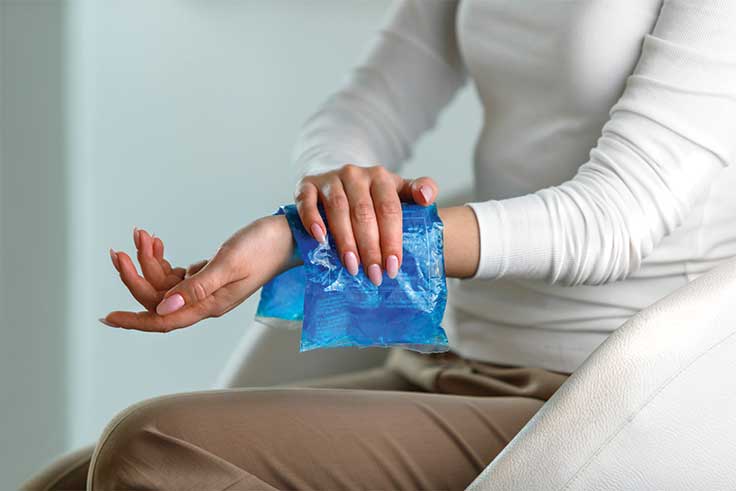Certain work activities may make the symptoms of carpal tunnel syndrome worse. These activities may include repeated bending of the wrist or fingers, accompanied by strong gripping. Constant use of vibrating machinery or tools may also contribute to the symptoms. However, the specific relationship between work factors and carpal tunnel syndrome is still not well-understood.
What is carpal tunnel syndrome?
The carpal tunnel is a part of the anatomy of your wrist. It’s a passageway that contains tendons and the median nerve. It’s on the palm side of your wrist – when you bend your fingers into a fist, the tendons that pull your fingers into your palm travel through the carpal tunnel. The boundaries of the tunnel are formed by bones and a tight ligament called the transverse carpal ligament. It’s the structure closest to your skin in the region of the carpal tunnel – it forms the palm-sided “roof” of the carpal tunnel.
Carpal tunnel syndrome is a syndrome because patients have a wide variety of symptoms. All these symptoms are related to compression (or pinching) of the blood flow within the median nerve.
The median nerve (inside the tunnel) is about as thick as a pencil and supplies sensation (feeling) to the thumb, index (pointer) finger, middle finger, and half of the ring finger.
Carpal tunnel syndrome is not just numbness or just pain. It can be a combination of both. The numbness and pain of carpal tunnel syndrome happen when the median nerve’s blood supply is squeezed by increased pressure in the carpal tunnel. This is similar to what happens when you step on a garden hose full of running water – the flow slows down or stops! This may cause numbness, tingling, “pins and needles”, and pain or aching – these symptoms may be there constantly or come and go during the day or night.
What are the causes?
Carpal tunnel syndrome can be caused by a variety of things. Here are some examples:
– swelling or inflammation around tendons
– increased fluid or edema in the body
– wrist fractures or other injuries
– arthritis
– diabetes
– tumors
– hypothyroidism
– pregnancy
Routine daily activities and hobbies may also contribute to worsening symptoms. Holding a book for long periods, use of power tools, driving, or crocheting are examples of common activities that may provoke symptoms.
What are the signs and symptoms?
Most patients with carpal tunnel syndrome have numbness, tingling and/or pain. Usually the small finger is not involved. The numbness may wake you up from sleep. Sometimes it helps to “shake it out” or massage the hand or wrist. Symptoms may be bilateral (on both sides) or involve only one side.
Patients may describe a feeling of clumsiness or weakness of the hand. You may notice that you drop things more often and doing fingertip-intensive tasks (like buttoning buttons) becomes difficult.
Muscle weakness/atrophy
Just below the thumb is a bulging pad of muscles called the thenar muscles. Some of these muscles control some of the thumb’s most important movements and are supplied by the median nerve. These muscles may begin to waste away with advanced carpal tunnel syndrome and make the thumb side of the palm look flattened compared with the other hand.
Treatment
Nonsurgical treatment of carpal tunnel syndrome is possible. It’s usually most effective for patients with mild symptoms. This involves avoiding activities that make symptoms worse (strong repetitive gripping, using vibrating tools, etc.). Splints are usually prescribed and are usually worn at night only, unless daytime use provides additional relief.
A steroid (cortisone) injection into the palm side of the wrist in the carpal tunnel may be recommended. This decreases swelling around the nerve and may provide lasting relief of numbness and pain.
Surgical treatment (carpal tunnel release) is recommended after nonsurgical treatment has stopped working or for patients who have more severe symptoms like muscle wasting and constant numbness.
Carpal tunnel release surgery is an outpatient procedure – you go home the same day of the surgery. This involves a small incision in the palm of your hand, near the wrist, through which the surgeon cuts (releases) the tight ligament on the palm side of the carpal tunnel. This relieves pressure on the median nerve. After surgery, you’ll have a soft dressing on your hand and begin moving your fingers right away in the recovery room to prevent stiffness.
The surgery increases blood flow to the median nerve and the first symptom to improve is night time pain and discomfort. Numbness is usually the last symptom to go away completely.
Soreness along the incision may last from 4-6 weeks. Soreness with deep pressure on the incision may last for a few months, but this is unusual. Improvements in symptoms depend on the severity and duration of those symptoms before surgery. Grip strength usually returns within three months after surgery.
Hand therapy may be recommended to reduce discomfort, regain strength, and improve range of motion in the fingers and hand.
Are you ready to find relief for your hand and wrist pain and improve your quality of life? You may call us at (479) 521-2752 to request an appointment or click the button below.

